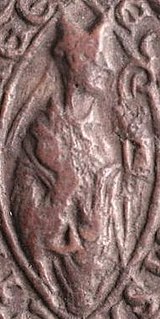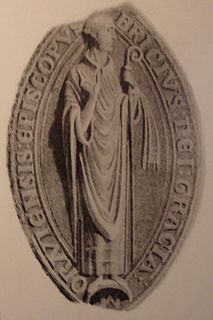Related Research Articles

Guillaume or William de Malveisin was Chancellor of Scotland, Bishop of Glasgow (1199/1200–1202) and then Bishop of St. Andrews (1202–1238).
Roger de Beaumont was Bishop of St Andrews.
Robert of Scone was a 12th-century bishop of Cell Rígmonaid. Robert's exact origins are unclear. He was an Augustinian canon at the Priory of St. Oswalds, at Nostell. His French name indicates a Norman rather than an Anglo-Saxon origin, but as he was likely born in the later 11th century, this may be due merely to the acculturation of his parents.

Bricius was prior of Lesmahagow and afterward bishop of Moray.
Robert Blackadder was a medieval Scottish cleric, diplomat and politician, who was abbot of Melrose, bishop-elect of Aberdeen and bishop of Glasgow; when the last was elevated to archiepiscopal status in 1492, he became the first ever archbishop of Glasgow. Archbishop Robert Blackadder died on 28 July 1508, while en route to Jerusalem on pilgrimage.

Henry de Lichton [de Lychtone, Leighton] was a medieval Scottish prelate and diplomat, who, serving as Bishop of Moray (1414–1422) and Bishop of Aberdeen (1422–1440), became a significant patron of the church, a cathedral builder, and a writer. He also served King James I of Scotland as a diplomat in England, France, and Italy.
Alexander de Kininmund was a 14th-century Scottish churchman. The first mention of Alexander occurs when, as a canon of Dunkeld he is one of three ambassadors sent by King Robert I of Scotland to Avignon in 1320. The purpose of this embassy was to present a letter to Pope John XXII known as the Declaration of Arbroath. As a papal chaplain and lawyer, he was well qualified to argue the Scottish cause, and Barrow makes a strong case that he was, in fact the author of the document.
Richard de Potton [de Poiton, de Pottock, de Poito] was a 13th-century English bishop. His name was likely derived his name from the town of Potton in Bedfordshire, England.
Radulf de Lamley [Ralph, Ranulf, Randalph de Lambley] was a 13th-century monk and cleric. Radulf's youth is obscure, and it is not until the 1220s that he emerges in the sources as a Tironensian monk, now Abbot of Arbroath. He held the leadership of Arbroath Abbey until 1239, when he was chosen to succeed Gilbert de Stirling as Bishop of Aberdeen.
Gilbert de Stirling was an early 13th-century bishop of Scotland. His background is unclear, perhaps coming from a burgess family of Stirling; he emerges in 1228 as the newly elected Bishop of Aberdeen, succeeding the recently deceased Adam de Kalder, after Matthew the Scot had turned down his own election in order to become Bishop of Dunkeld.
Alexander Gordon was a late medieval Scottish churchman. He was member of the kindred of the Earl of Huntly, being cousin to the reigning earl. He was the third son of James Gordon, Laird of Haddo.
Robert Forman was a late medieval Scottish churchman. He was the son of one Janet Blackadder and her husband, a Berwickshire landowner named Nicholas Forman of Hatton. Sometime before 11 February 1500, he was made Precentor of Glasgow. He was Dean of Glasgow from 1505, a position he would hold until his death. Between 1506 and 1511 he was also in possession of the Chancellorship of the diocese of Moray.
Adam de Kald [de Kalder, Crail] was an early 13th-century Bishop of Aberdeen. His name, de Kald or de Caral could refer to, among other places, Calder in Nairnshire or Crail in Fife. Either location may mark his origin place, but this is speculation. There is a river in West Yorkshire called Calder. His origins remain obscure.
John was a late 12th century and early 13th century Tironensian monk and bishop. By the time he first appears in the records, as Bishop-elect of Aberdeen in December 1199, he was the prior of Kelso Abbey, that is, deputy to the Abbot of Kelso. He achieved consecration as Bishop of Aberdeen by 20 June 1200, though the date on which this took place is unknown.
Matthew was a 12th-century churchman residing in Scotland. He is the first man known to have held the position of Archdeacon of St Andrews, his first known ecclesiastical post. He occurs in this office in a document which can be dated to some point between August 1147 and June 1152. Bishop Edward, Bishop of Aberdeen, died in 1172 and Archdeacon Matthew was elected as the successor. He was consecrated on 2 April 1172.
Edward [Ēadweard, Eadward, Édouard, Étbard] was a 12th-century prelate based in Scotland. He occurs in the records for the first time as Bishop of Aberdeen in a document datable to some point between 1147 and 1151. His immediate predecessor, as far as the records are concerned, was Bishop Nechtán. The latter can be shown to have been active at least between 1131 and 1132, and possibly as late as 1137. Edward's accession must have occurred, then, sometime between 1131 and 1151, with a date after the 1130s more likely than not.
James Ogilvie [Ogilvy] was a late medieval Scottish prelate. After the death of William Elphinstone, the bishopric of Aberdeen became vacant. Ogilvy was nominated for the vacancy by John Stewart, Duke of Albany. At Rome however, Pope Leo X provided Robert Forman to the vacant see, while the canons of Aberdeen elect Alexander Gordon, allegedly under pressure from the latter's cousin Alexander Gordon, 3rd Earl of Huntly.

Henry was a 13th-century Augustinian abbot and bishop, most notable for holding the positions of Abbot of Holyrood and Bishop of Galloway.

Albin was a 13th-century prelate of the Kingdom of Scotland. A university graduate, Albin is known for his ecclesiastical career in the diocese of Brechin, centred on Angus in east-central Scotland.

Cum universi is a papal bull written by Pope Celestine III, issued on 13 March 1192. The bull ended the claim of the Archbishop of York to metropolitan jurisdiction in Scotland and established an independent national church, albeit one with no figurehead.
References
- Cowan, Ian B., The Medieval Church in Scotland, (Edinburgh, 1995), pp. 104–5
- Dowden, John, The Bishops of Scotland, ed. J. Maitland Thomson, (Glasgow, 1912), pp. 104–5
- Innes, Cosmo, Registrum Episcopatus Aberdonensis: Ecclesie Cathedralis Aberdonensis Regesta Que Extant in Unum Collecta, Vol. 1, (Edinburgh, 1845), p. xxiv
- Keith, Robert, An Historical Catalogue of the Scottish Bishops: Down to the Year 1688, (London, 1924), pp. 107–8
- Watt, D.E.R., Fasti Ecclesiae Scotinanae Medii Aevi ad annum 1638, 2nd Draft, (St Andrews, 1969), pp. 1–2
| Religious titles | ||
|---|---|---|
| Preceded by Radulf de Lamley | Bishop of Aberdeen 1247–1256 | Succeeded by Richard de Potton |